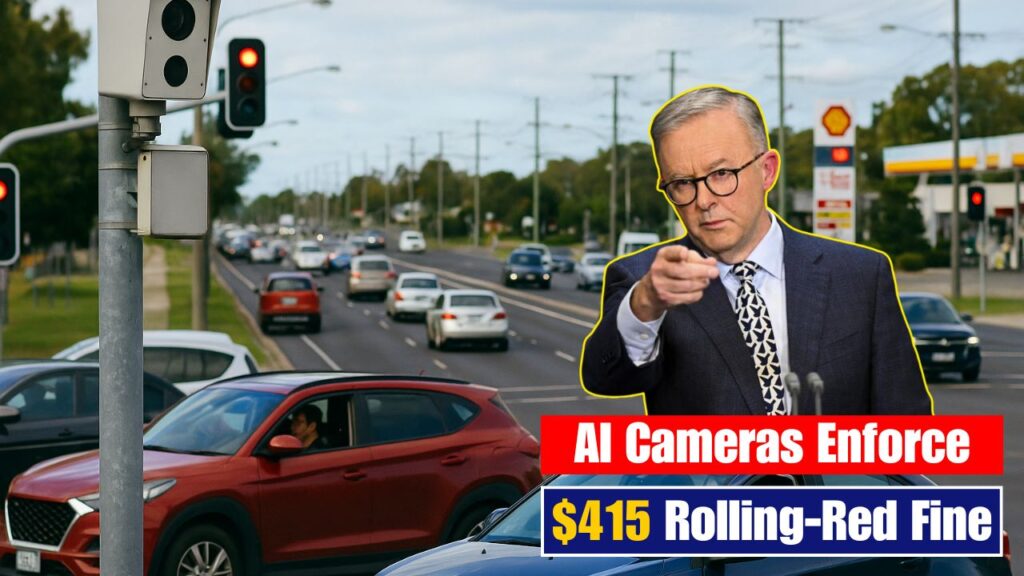Australia is introducing a major safety crackdown as a new $415 rolling-red fine officially takes effect on 2 December, targeting drivers who fail to fully stop at intersections. With advanced AI cameras now being deployed across the country, authorities aim to reduce accidents caused by rolling through red or amber lights. This update has caught the attention of motorists nationwide, who are being urged to understand the new enforcement rules, penalty amounts, and the technology behind these automated detections. The shift marks a significant upgrade in Australia’s efforts to curb dangerous intersection behaviour.

New Rolling-Red Fine Rules for Australian Drivers
The introduction of the $415 rolling-red fine represents a major shift in how traffic enforcement operates across Australia. Authorities are tightening compliance as drivers continue to commit intersection violations that lead to preventable collisions. With AI systems trained to detect full stops required and moment-by-moment behaviour, even minor rolling movements can now trigger penalties. This pushes motorists to adopt safer driving habits and maintain caution at busy intersections. Through consistent monitoring and nationwide safety upgrades, the goal is to reduce road trauma and encourage responsible decision-making among Australian drivers.
AI Camera Enforcement Expands Nationwide
The rollout of AI-powered cameras is a central part of these advanced road checks, allowing authorities to monitor intersections with unprecedented accuracy. These systems analyse vehicle movement, speed, and stopping patterns in real time, identifying violations that older cameras often missed. Drivers can expect enhanced detection zones operating around the clock, significantly reducing the chances of human error during enforcement. The initiative also brings modern traffic control into everyday commuting, offering a more consistent approach to penalty issuance. This nationwide upgrade is designed to protect communities and ensure intersection risk reduction across Australia.
Impact of Rolling-Red Penalties Across Australia
The new enforcement rules are expected to influence driving habits and reduce intersection crash risks significantly. Motorists who previously treated red-light stops casually will now face immediate consequences captured through automated recordings. The introduction of strict safety measures aims to push drivers toward full compliance, particularly in high-risk urban areas. With millions of Australians navigating congested roads daily, the system promotes consistent road discipline and guarantees that violations receive appropriate attention. This initiative also encourages public safety awareness by reminding drivers that AI systems leave very little room for error or leniency.
Summary and Final Analysis
This new $415 rolling-red camera enforcement system marks a transformative moment in Australia’s road-safety strategy, supported by technology-driven monitoring and data-based decisions. By relying on AI rather than manual oversight, the government aims to deliver accurate violation tracking and reduce avoidable crashes at intersections. As more cameras are deployed nationwide, drivers should expect stricter compliance rules and more consistent penalties for risky behaviour. Overall, the policy is expected to create long-term traffic improvement, shaping safer road habits for millions of Australians.
| Enforcement Element | Details |
|---|---|
| Fine Amount | $415 fixed penalty |
| Start Date | 2 December 2025 |
| Technology Used | AI-powered cameras |
| Key Target | Rolling through red lights |
| Coverage | Nationwide intersections |
Frequently Asked Questions (FAQs)
1. What is the new rolling-red fine amount?
The new rolling-red penalty is a fixed $415 fine.
2. When do the new rules officially start?
The rules come into force on 2 December 2025.
3. Are AI cameras used for detecting violations?
Yes, AI-powered cameras automatically detect rolling-red breaches.
4. Do drivers need to make a full stop?
Yes, vehicles must come to a complete halt at red-light intersections.




